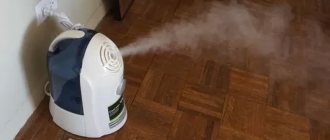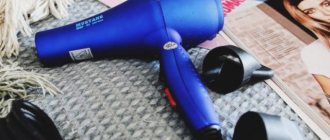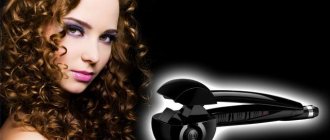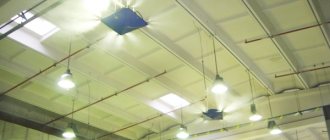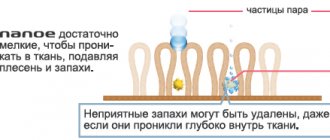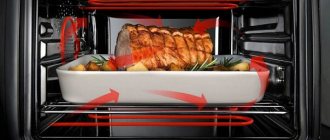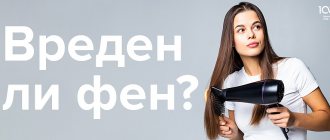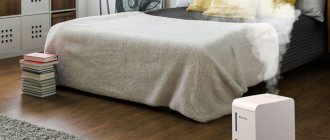Drying Rule #1: Gently wring out hair
The first thing you need to do is remove excess moisture from your hair. Because of it, the cuticle (the protective shell of the hair, consisting of transparent keratin scales) swells, which leads to increased fragility and increases the risk of split ends. Therefore, the shorter the contact with water, the better.
It is best to remove moisture with a soft, highly absorbent towel, such as microfiber. Do not rub your hair under any circumstances! This will have a detrimental effect on your hair. Vigorous rubbing damages the cuticle, softened by water, its scales literally stand on end. Because of this, the hair loses its smoothness and ability to reflect light, which means you can’t count on shine. The best way is to gently press a towel onto your hair and squeeze out the moisture. If you have long braids, you can twist them into a rope in a towel and then wring them out. It is enough if after this preliminary drying there is no water dripping from the hair.
Drying rule No. 3: do not neglect thermal protection.
It doesn't completely protect your hair or reduce hair dryer damage, but it helps. In general, thermal protection works like this: a product with special components coats the hair and redistributes heat. In addition to thermal protection, hair oil will also play a good role. Apply it to damp hair, let it absorb a little and proceed to dry your hair. Hot air activates protective substances, and you will achieve perfect styling without harm to your hair!
Drying rule #5: Don't overdry your hair.
When drying with a hairdryer, you need to “keep a distance” - about 20 cm and constantly monitor the temperature. Plus, you can purchase a hair dryer with an ionic effect. To keep your hair smooth and shiny, direct the air from top to bottom. This is how you smooth out the scales. Stylists also recommend leaving your hair slightly under-dried to avoid evaporation of all moisture from the hair structure and destruction of the protective shell. At the end of drying, it is best to switch the hair dryer to cold blowing mode: this will smooth out the cuticle scales, add shine and help quickly “cool” the hair.
Why do you need cold air in a hair dryer?
Everyone is well aware that frequent use of hot air streams in a hair dryer can damage the appearance of the strands. To prevent this from happening, manufacturers have come up with a safe drying mode.
Most often, cold blowing is used to fix the shape of the styling. When forming large and round curls, hot air is used. To prevent this form from quickly deteriorating, it is best to spray it with a stream of low-temperature air. To keep your hair even more in one position, it is best to use hairspray.
Attention! It is equally often recommended to use this blow-dryer to style extensions. As girls know, hair extensions are attached to natural ones using a special adhesive solution. But it can be destroyed by prolonged contact with high temperatures. Therefore, it is recommended to use cold air so that less hair extensions fall out from the head.
Drying Rule #6: Use attachments.
There are 2 types of hair dryer attachments: concentrators and diffusers. What are concentrator attachments? The concentrator is a flattened cylinder that fits onto the nozzle of a hair dryer. The air comes out of this nozzle differently - in a narrow and strong stream, which reaches maximum pressure precisely at the strand to which it is directed. And it intensively warms up this strand. The hair dryer itself has a relatively wide socket, from which hot air comes out at high speed ─ in a wide and voluminous stream, freely diverging throughout the space.
What is the concentrator attachment for? This nozzle itself speaks about its function by its name. The nozzle concentrates air on a specific strand, thereby preventing other strands from overheating.
What are the dangers of using a concentrator? The air stream from the hairdryer should not be directed at the skin at all. Faces and ears are clear to everyone. But more than that, it should not be directed to the scalp. Dry so that only your hair is exposed to the stream. Otherwise - dry skin, dandruff or even small burns. So, when using a concentrator you need to be as careful as possible in this regard. When it comes to hair, when using a concentrator you need to work quickly and time your work with the strand well. Don't overdo it and don't fall asleep with your eyes open while working with a hairdryer. If the strand is already ready, cool it and move on. In addition, remember - the distance between the nozzle of the concentrator and the strand should never be less than 2-3 centimeters.
What are diffuser nozzles? Unlike concentrator nozzles, diffuser nozzles work in the opposite way - they break the air stream into several weaker ones, due to which the hair suffers much less. The diffuser, unlike the concentrator attachments, is attached to the hair dryer with a narrow part. At the base of the teeth there are holes through which air enters. It is this design feature that helps reduce the negative impact of high temperatures on the health of the hair and scalp.
What is a diffuser nozzle used for? Diffuser attachments create that natural effect of root volume and light curls.
Which diffuser should I use? The Termix diffuser is a universal tool that is suitable for any hair length and thickness. Due to the specially selected distance between the teeth, long hair will not get tangled, and short hair will be completely captured. High quality plastic will not melt, allowing you to use the diffuser every day. Made of silicone tube, the Termix diffuser will not slip or fall off your hair dryer, which usually happens with concentrate attachments. And also two superimposed filters with a rotating base allow you to adjust the required volume of hair and create additional comfort during styling.
Blow-drying hair: features of the procedure
Few modern women today do without a hairdryer. For example, it is indispensable when it is necessary to speed up the drying of washed hair. This is one of the advantages. Here are the others:
- combines drying and styling functions;
- creates hairstyles of any volume;
- adds root volume;
- Suitable for hair of any length.
Experts agree that frequent drying with hot air really damages your hair. However, if you use the device without fanaticism, correctly regulate the flow temperature, and use thermal protection means, the negative consequences can be minimized.
The higher the heating temperature and the stronger the air flow from the hair dryer, the more hair is damaged.
Ways to protect hair
There are many cosmetic compositions that can protect hair from the damaging effects of high temperature and mechanical stress during drying with a hairdryer and comb. The basic products are water-washable formulations that are used at the hair washing stage. These are shampoos, masks, balms, conditioners that moisturize and strengthen the structure.
The most effective means of thermal protection are considered to be leave-in formulations with special components that prevent overheating of hairs, available in the following forms:
- sprays;
- oils;
- creams;
- serums;
- gels and others.
Thermal protection products have their own characteristics; they can be designed not only to protect against high temperatures, but also to solve other problems
Such products are applied after washing and removing excess moisture from the hair. They can be distributed along the entire length or only on the ends. In addition to heat-protective properties, these compositions may have additional capabilities: promote straightening, provide shine and smoothness, make hair manageable, etc.
Always apply a heat protectant before using heat styling tools such as a blow dryer, curling iron or straightening iron. Heat protection spray provides additional hold. To create additional volume, use a heat-protective mousse: apply it to your hair at the roots.
Armin Morbach, stylist at Schwarzkopf
https://www.schwarzkopf.ru/ru/hairstyling/%D0%BF%D0%BE%D0%BB%D0%B5%D0%B7%D0%BD%D1%8B%D0%B5-%D1% 81%D0%BE%D0%B2%D0%B5%D1%82%D1%8B/professional-hair-styling-methods.html
The following recommendations will also help protect your hair from the negative effects of a hair dryer:
- after washing your hair, wrap your head in a towel that will absorb excess moisture and leave it for a while;
- You can determine the optimal temperature of the air flow by directing it to the back of your hand (there should not be a “burning” sensation);
- keep the device at a distance of 20 cm from your hair;
- To prevent thin hair from getting tangled or breaking during subsequent combing, use a low air flow rate;
- constantly change the drying zone to prevent spot overheating;
- if you need to dry your hair as quickly as possible, use the mode with maximum blowing power, and not with high temperature;
- use plastic or wooden combs, because metal products heat up and increase the temperature effect on the hair;
- When finishing drying, turn on the cold air supply to close the hair scales.
Drying Rule #8: Use the right styling tools.
This rule follows from the previous one. If you want to achieve root volume, it is not at all necessary to dry your head upside down, just use brushing. To make your styling safer, without thermal and mechanical damage, use Termix brushes. Termix brushes are represented by the following lines: Evolution with Teflon cylinders, Professional with aluminum cylinders and C-Ramic with ceramic cylinders. Just as we use blow dryers based on the condition of the hair, we also use brushing. Termix Evolution with Teflon cylinder. Teflon saves up to 30% of drying time because the diamond-shaped holes allow 10% more air to pass through. • Termix Evolution Basic . For normal hair. Thanks to the combination of the tube design and the number and thickness of ionized nylon fibers, thermal brushing combats the dehydration problems that occur in this hair type • Termix Evolution XL. + 3 cm length allows you to capture more hair in one stroke, create perfect curls with the effect of curly ends or the effect of using a curling iron, with a longer and more natural result. • Termix Evolution Soft. For thin and damaged hair. Removes static electricity, which negatively affects hair and prevents breakage of fine hair. It also eliminates static electricity, gives greater brightness and is ideal for working with fine hair. • Termix Evolution Special Car e. For sensitive and severely damaged hair. An exclusive combination of fibers allows you to get the most smooth and silky hair without damaging its natural structure.
Termix Professional with aluminum cylinder and nylon bristles. Nylon fibers restore their original shape after exposure to heat - do not damage hair - maintain and distribute temperature evenly, reducing drying time. Antistatic brushes from the Professional series are suitable for creating all types of hairstyles. Termix ceramic brushes: • Termix C-Rami with ceramic cylinder maintains and distributes temperature evenly, reducing drying time. It also gives shine and softness to hair. • ermix Color. Limited edition colors: Bubblegum, Princess Blue, Coral.
Drying rule No. 9: do not forget about cold airflow.
Cold blowing closes the hair scales and fixes the hairstyle. A strand of hair, curled and styled as needed under a hot air dryer, is suddenly blown with cold air. 4-5 seconds of blowing - and that’s it, you can move on to the next one, this one is fixed. Why is this happening? The fact is that the elasticity of hair depends greatly on its temperature. Hot hair changes shape more easily. Then we reason logically - a heated strand, laid in the shape you need, remains heated. And while you start working with the next strand, this one begins to lose the shape it was given. Cooling stops this process and fixes the hair exactly in the position in which it is currently located. And then it keeps this shape well. By the way, the cold blow button on professional hair dryers is located so that it can be pressed briefly without being distracted by the switch that turns off the heating.
For hair extensions
If the strands are secured with hairpins, they must be removed and the hair dried with a cold hairdryer. Hair extensions are usually a little shinier, add shine to your hair using a hair dryer. Blow-drying with hot air will heat the clips and cause discomfort.
If your hair is glued, hot air can destroy it, especially if you style or dry your hair more than three times a week. The dried glue slides off the hair and the extensions fly off.

